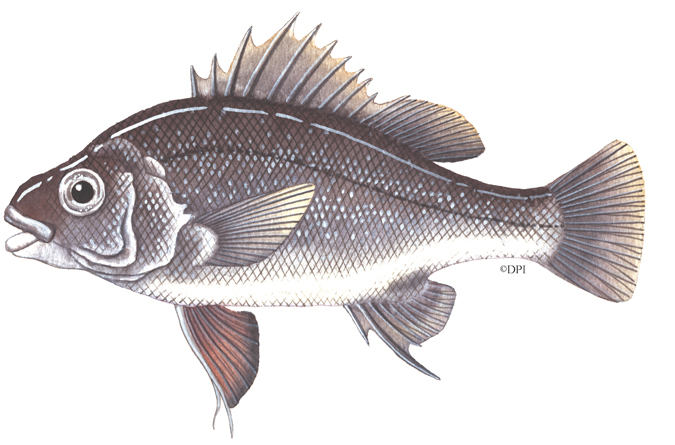Macquarie perch

| Common Name: | Macquarie perch |
| Other Name/s: | Silvereye, white-eye, bream, black bream, Murray bream, Goulburn bream, Murray perch, mountain perch, black perch |
| Family: | Percichthyidae |
| Scientific Name: | Macquaria australasica (Cuvier, 1830) |
| Origin: | Native |
Click here to read about how we are recovering Macquarie perch in Victoria
Conservation Status
State: Classified as "endangered" under the Flora and Fauna Guarantee Act 1988.
Federal: Classified as "endangered" under the Environment Protection and Biodiversity Conservation Act 1999
Description
Tapered snout with upper and lower jaws of equal length. Conspicuous pores on the lower jaw. Back colouration varies from black or dark silvery-grey, dark brown to dark-grey, bluish-grey or green-brown on the upper body.
Sides are lighter, belly is usually paler to off-white, often with a bronze or yellowish tinge. Pectoral fins grey to yellowish. Pelvic fins often rosy with black edges, and other fins generally greyish, often with a purplish tinge. Juvenile fish are often mottled on the back and sides. Second spine in the anal fin is longest.
Distribution
Occurs naturally north of the Great Dividing Range in tributaries of the Murray-Darling system.
Introduced to a number of waters south the Divide, but now persisting as self-supporting populations only in the Yarra River and Wannon River.
Abundance and distribution reduced by construction of dams on streams, changes to river flow and temperature regimes, siltation of spawning streams and impact of introduced species including trout and redfin. Redfin virus has probably had a major impact on Macquarie perch populations.
Habitat
Naturally a riverine fish, preferring deep holes. Cool, upper reaches of Victorian tributaries of the Murray-Darling system. Does well in impoundments with suitable spawning streams (Victoria's best population is in Lake Dartmouth where this large lake is fed by suitable shallow spawning streams including the Mitta Mitta River).
Brief Biology
Can attain a weight of 3.5 kg, but more commonly in Victoria at a length of 35-40 cm and weights of 750 g-1 kg. Males can mature at 2 years of age and up to 21 cm; females at 3 years of age and up to 30 cm, although local conditions may induce the species to breed at smaller or larger sizes.
Females of 30 cm or larger may produce between 50,000 and 110,000 eggs. Spawning usually occurs during spring or summer (October-January) with water temperatures between 16 and 22°C. Breeding occurs in flowing water where there are rock or gravel substrates. Eggs hatch after 10 to 18 days. Growth can be rapid, a five-year-old fish being 38 cm. Fish of 10 years of age have been collected. Carnivorous, taking its food by a sucking motion, principal diet items being aquatic insects with some crustaceans and molluscs.
Other Notes
Good angling and excellent eating. Range and abundance have been greatly reduced during the past 50 years and, with the exception of the population in Lake Dartmouth, and smaller populations in several other localities, most occurrences of the species are limited to small numbers of fish.
Now being propagated under hatchery conditions; juvenile fish are being released into a number of waters with the objective of restoring or re-establishing viable populations of Macquarie perch in suitable waters.
Mature fish have also been translocated from Lake Dartmouth to Lake William Hovell on the King River and Lake Eildon.
Regulations
Recreational Fishing Licence requirements, and the regulations affecting the taking of Macquarie perch in Victoria, are provided in the Victorian Recreational Fishing Guide, available free from RFL sales agents.
Further Reading
- A Guide to the Freshwater Fish of Victoria, Phillip Cadwallader & Gary Backhouse, Department of Conservation and Environment.
- Australian Freshwater Fishes, John R. Merrick & Gunther E. Schmida.
- Biological Information for Management of Native Freshwater Fish in Victoria, J D Koehn, W G O'Connor.

